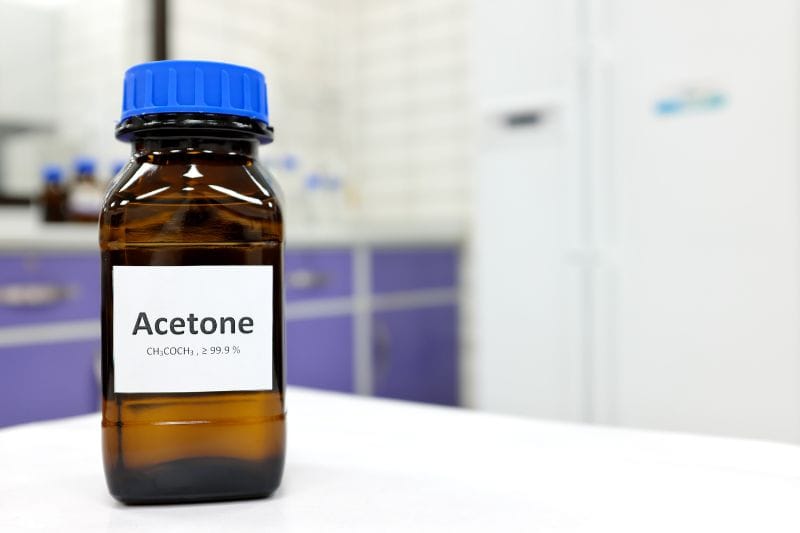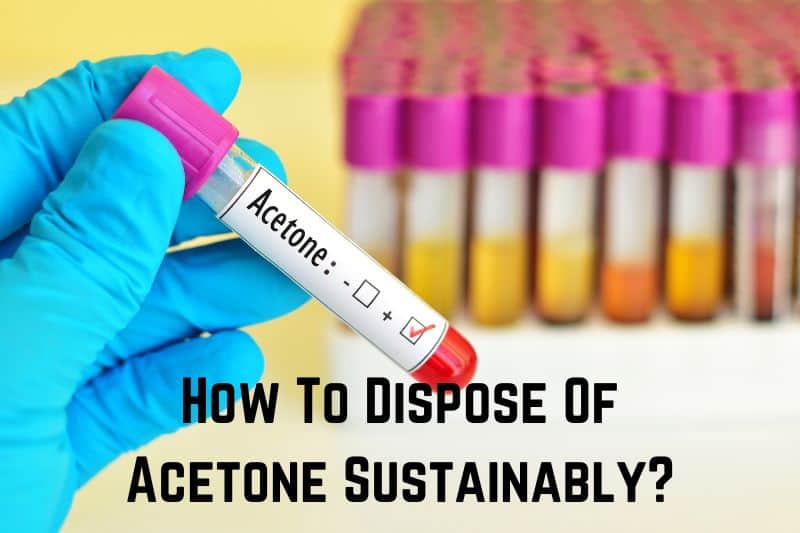One solvent that’s frequently utilized in 3D printing is acetone. The most popular kind of plastic associated with 3D printing, ABS plastic, gets dissolved with it. Another method for smoothing the surface of 3D printing is acetone.
Acetone should be disposed of carefully because it can catch fire. Pouring acetone into a sealed container is the easiest way to eliminate it. The container can be thrown in the garbage once it is filled.
Read: How To Dispose of a Hot Tub Sustainably? (Read on)
What is Acetone?
Acetone is a chemical compound belonging to a family of organic compounds with a double bond between carbon and oxygen in their functional group. Its IUPAC name is propanone, and its chemical formula is (CH3)2CO.
Other names for this compound are 2-propanone, dimethyl ketone, and beta-keto propane. Acetone is commonly sold in paint thinners and nail polish removers. Since it is soluble in water, acetone is a crucial organic solvent for workplace, home, and lab use.
In 2010, about 6.7 million tons were manufactured globally, mostly as a solvent and to make bisphenol A and methyl methacrylate, precursors to common plastics. It is a typical organic chemistry building unit. In the US, it has a volatile organic compound exemption.
In the human body, acetone is created and eliminated by regular metabolic processes. It typically exists in urine and blood. Individuals who suffer from diabetic ketoacidosis generate more of it. For children with refractory epilepsy, ketogenic diets that raise blood levels of ketone bodies are used to prevent epileptic attacks.
The bulk of acetone discharged into the ecosystem is industrially produced even though acetone is naturally found in trees, plants, volcanic gasses, forest fires, and the decomposition of body fat. Even in water and soil, acetone evaporates quickly.
Mixtures of powerful sulfuric and nitric acids are incompatible with acetone. When combined with chloroform amid a base, it could also blow up. It can oxidize to produce acetone peroxide, a very unstable and explosive chemical, by interacting with hydrogen peroxide.
Various Ways To Dispose of Acetone
Acetone disposal is simple if you take the necessary precautions. Before you start, ensure that you are sure that you possess your safety supplies. Three approaches have been delineated for the proper disposal of acetone. The following are some safe methods for getting rid of acetone:
Acetone Cleaning Products
Acetone in trace amounts does not harm the environment. Place cotton wool or swabs treated with acetone in a plastic waste bag. Once tied, dispose of the bag with your regular household waste.
After disposing of the saturated cotton balls, you must wash your hands. Squeeze the cotton balls to remove any extra acetone in a different container if there is a lot of it. Close the container and take it to a recycling facility to get rid of it.
Leftover Acetone
Disposing of old nail polish, remover, and residual acetone is also crucial. Store the nail paint and remover bottles in a different container that you can no longer use at home or in your salon.
Drop this container off at the nearest recycling facility for hazardous material. The acetone nail paint remover should never be poured down the sink. In a similar vein, transfer any residual acetone into a container that can be sealed. Keep it away from heat sources and anything combustible.
Locate a recycling facility after you have put them in a safe container. You can find recycling facilities in your particular area by using these websites.
Acetone Paint Thinner
Put on a mask and protective gloves before discarding acetone paint thinner. This is to shield you from the paint thinner’s acetone fumes. Use a coffee filter to filter the leftover paint thinner into a jar or other airtight container.
The thinner will go into the jar, but the paint will collect in the filter. Tightly shut the jar’s lid or cover the container. After letting the paint dry in the coffee filters, wrap them in newspaper and discard them in the household garbage. The gathered acetone in the jar can be used as a thinner for paint. Locate a recycling and disposal site for hazardous waste close to your home.

Is Acetone a Hazardous Material?
Acetone is a hazardous substance that can harm human health and the environment because it is not recyclable. If you use acetone cleaner to clean coins or operate in a nail salon, you must wash your hands afterward and dispose of them in the appropriate receptacles.
Leave the windows open if you use a product that contains acetone. You might even have to put on a mask in certain situations. Acetone is an extremely harsh chemical, which explains why. Very tiny doses can bring on severe breathing issues.
Another extremely flammable substance is acetone. It will catch fire if an open flame comes near it. In actuality, practically everything near the acetone will light up in addition to the acetone itself.
Acetone is a chemical, as you can surely imagine, that requires careful disposal. You risk your trash can catching fire if you do not. There is a chance that acetone will catch fire anywhere from your house to the landfill.
It is just that combustible. Although the risk is present, it is unusual that something may ignite the acetone. Acetone will begin to seep into the soil nearby if it is disposed of inappropriately in the ground. This will render the ground unusable for farming.
Can You Pour Acetone Down the Drain?
Acetone is an extremely potent solvent that can seriously damage your plumbing system. It can lead to expensive repairs by corroding pipes and causing clogs. Therefore, refrain from dumping acetone down the drain unless you intend to be knee-deep in plumbing expenditures. The danger is not worth it.
Acetone is a strong solvent, which is the initial thing to realize why this would be such a horrible idea. At its core, it is still a strong chemical, even if we use it routinely for removing fake nails or old nail lacquer.
Additionally, while using it on cotton balls, there may be problems that we need to be aware of. Most plumbing systems’ pipes are composed of PVC, a type of plastic, rather than metal. This is acceptable for typical items that pass through pipes, so there is no need to worry.
However, the pipes may melt if you pour your acetone down the sink. Similar to how it works on your nails, it dissolves the PVC layers until they are completely gone.
Even though a small amount of acetone is generally not enough to destroy the whole plumbing system, a large amount of excess acetone might dissolve most of the piping in the structure. Moreover, you would want to stay away from that mess.
Can You Flush Acetone Down the Toilet?
Flushing acetone down the toilet is strictly forbidden. Acetone can harm the plumbing in your home and give you many headaches, similar to what it can with the drain.
No matter how much acetone you flush down the toilet, it will likely wind up in a sewage treatment plant before being discharged into the environment. Sewage treatment facilities are excellent at handling garbage and other obstacles but need help handling chemicals.
Thus, acetone that escapes your drains may end up in an aquatic environment without significantly altering its composition. Acetone will leak out of the tank onto your yard so that you can see the sick animals and damaged plants outside your window.
The most dramatic argument—if not the most prevalent—is that it might blow up. Acetone burns extremely easily. The vapor itself can start explosions with a single spark. And since you did not want to take a trip to a hazardous waste site, the last thing you would like is for your home’s sink or a neighboring waterworks system to blow up.
Can You Reuse Acetone?
You may have wondered if acetone is reusable since throwing it away after only one usage seems wasteful. The good news is that, with caution, acetone can be reused. To get rid of any nail polish residue left behind after applying acetone to get rid of nail polish, you may pour the mixture over a coffee filter.
After that, you can save it for later use in a well-sealed glass container. Just be careful to label it properly to avoid mistakenly thinking it is your morning coffee! Since acetone is such a flexible solvent, recycling it and reusing the recovered product makes more sense than buying a new solvent.
Read: How To Dispose of Tampons Sustainably? (Quick Guide)
The greatest strategy to stay ahead of demand is to recycle and recover your spent acetone, as the market for the substance is expanding and supply is decreasing. Becoming an eco-friendly business when recycling used acetone has further advantages.
Even while it is beneficial for businesses to engage in charitable endeavors, it is also an excellent way to demonstrate to your clientele that you are making an effort to be environmentally conscious. You may cut down on trash disposal, purchases of new chemicals, and storing dangerous chemicals by recycling your solvents.
Conclusion
Although acetone is a safe solvent for home use, it should be disposed of properly. It should be disposed of following your area’s hazardous waste disposal legislation. Acetone must also be kept in a sealed container to avoid spills.
Acetone can have negative effects on the environment and your health. Pouring leftover or old acetone into a sealable container is the first thing to do if you need to get rid of it. Next, choose a recycling center in your area and deliver the container there.






